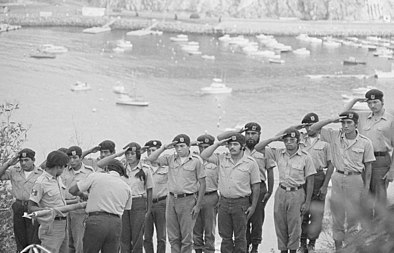Occupation of Catalina Island facts for kids
Quick facts for kids Occupation of Catalina Island |
|||
|---|---|---|---|
| Part of Chicano Movement | |||

Members of the Brown Berets in formation, 1972
|
|||
| Date | August 30 – September 22, 1972 (23 days) | ||
| Location |
33°20′52″N 118°19′44″W / 33.34778°N 118.32889°W |
||
| Caused by | Violations of the Treaty of Guadalupe Hidalgo | ||
| Goals | Awareness of oppression of Mexican Americans | ||
| Parties to the civil conflict | |||
|
|||
| Lead figures | |||
|
|||
| Number | |||
|
|||
The Occupation of Catalina Island began on August 30, 1972. A group called the Brown Berets took over Catalina Island for three weeks. This island is located off the coast of Los Angeles.
The Brown Berets were a group that fought for the rights of Mexican Americans, also known as Chicanos. Their leader, David Sanchez, said that Catalina Island really belonged to Mexico. They wanted the island's 42,000 acres of undeveloped land to be used for housing.
Contents
Why the Occupation Happened
David Sanchez was inspired by another protest. Three years earlier, a group of Native Americans had occupied Alcatraz Island.
Sanchez read the Treaty of Guadalupe Hidalgo. This treaty was a peace agreement that ended the Mexican American War in 1848. He noticed that Catalina Island and the Channel Islands were not directly mentioned in the treaty. Because of this, he believed they still belonged to Mexico.
The Brown Berets wanted to use the occupation to show people something important. They wanted to highlight how Mexican Americans had been treated unfairly. They felt that since the treaty was signed, Mexican Americans had been kept from having a say in their own communities.
The Occupation Begins
On August 30, 1972, the local island newspaper, The Catalina Islander, reported on the event. It said that a group of young Brown Berets were found camping on a bluff. This spot was above the Casino on Santa Catalina Island Company property.
The group had 26 members of the Brown Berets. They put a large Mexican flag on the point above the Chimes Tower. They named their camp “Campo Tecolote,” which means "Camp Owl."
Life During the Occupation
According to David Sanchez, the group did not have many supplies. He later said he only had $800 for the whole operation. They used this money to buy food.
Many Mexican American girls from the island helped them. They would bring food like enchiladas and beans to the camp.
John Regalado, who lived in Avalon, noticed how some people reacted. He said that locals started calling the occupiers the "Brown Burritos." This was meant as an insult instead of "Brown Berets."
The mayor of Avalon, Ray Rydell, did not involve the police right away. He waited several weeks. He believed that if he had called the police, the ACLU would have gotten involved. The ACLU is a group that protects people's rights.
How Locals Reacted
People on the island reacted differently to the Brown Berets. Their reactions often depended on their background.
Some local Mexican American families supported the group. These families often worked as maids or in the service industry on Catalina. Maria Lopez, who lived on Catalina at the time, shared her story. She told the Los Angeles Times that her mother and aunts made food for the group. Her father then delivered it to the Berets' campsite.
Lopez explained the different reactions. She said, “The Mexican people here, the Chicanos, welcomed them. But a lot of the gringos, they were afraid they were coming to take over.”
Many white townspeople reacted very negatively to the Berets. Mayor Rydell called the occupation "an invasion." He even compared the Berets to Nazis. He wrote that in Avalon, there were "no hyphenated Americans." He meant there were no Irish-Americans or Mexican Americans, just "Americans." He told people not to let the "racist Brown Berets confuse" them.
The occupation made some white townspeople very angry. A group of them even formed a mob to attack the Berets. The Catalina Islander reported that this "vigilante-type" mob gathered at the country club. They planned to "go up and pound” the Berets. However, Sheriff Jack Vaughn convinced them to stop. He told them to let law enforcement handle the situation.
The Occupation Ends
The occupation lasted a little more than three weeks. On September 22, 1972, policemen arrived. They were from the Los Angeles County Sheriff's office. They came to enforce a rule about how land could be used.
The Brown Berets did not fight back. They were escorted off the island. A story from the time says that the Berets chanted "Chicano Power" as they left. Meanwhile, the white townspeople sang "God Bless America."
After their departure, Mayor Rydell wrote about the experience. He said, "living in the same town with these soggy, chocolate soldiers for three weeks was not pleasant for anybody."
What Happened Next
Six years after the occupation, in 1978, Mexico made an important decision. The government of Mexico officially recognized that the U.S. had control over Catalina and the Channel Islands. This was part of a maritime treaty between Mexico and the United States. This treaty was an agreement about the sea borders between the two countries.

